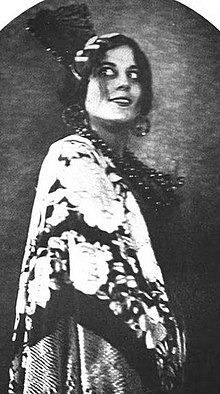Carmen Tórtola Valencia



Carmen Tórtola Valencia (June 18, 1882 – February 13, 1955) was a Spanish early modern dancer, choreographer, costume designer, and painter, who generally performed barefoot. Tórtola Valencia is said to have been the inspiration for Rubén Darío's poem, La bailarina de los pies desnudos ("The Barefoot Dancer").[1]
Biography
[edit]Born in Seville to a Catalan father (Florenç Tórtola Ferrer, d. 1891) and Andalusian mother (Georgina Valencia Valenzuela, d. 1894), she was three years old when her family emigrated to London. In his book Tortola Valencia and Her Times (1982), Odelot Sobrac, one of her early biographers, said Tórtola Valencia developed a style that expressed emotion through movement and that she was inspired by Isadora Duncan. A member of Generación del 13, her costumes are part of the collection of Centre de Documentació i Museu de les Arts Escèniques. Her Spanish modernismo style enabled a career as a solo concert dance artist who performed classic, Oriental, and Spanish pieces.[2] She made her debut at the Gaiety Theatre in London (1908), appearing at the Berlin Wintergarten theatre and the Folies Bergère of Paris in the same year. She performed in Nuremberg and London in 1909.[3] One of the people she taught was the Anglo-Indian dancer Olive Craddock aka Roshanara.[4] In 1911, she made her Spanish debut at the Romea Theatre of Madrid. She was at the Ateneo de Madrid in 1913.[3]
The feminist
[edit]Tórtola Valencia was also a "pioneer Spanish feminist of the 20th century".[5] Being gay and having leftist ideas, Tórtola Valencia was jailed at the end of the Spanish Civil War. In 1928, she met Magret Angeles-Vila and they were inseparable thereafter. She danced for the last time in 1930 in Quito. She began painting in Barcelona where she died in 1955 and is buried at Poblenou Cemetery.[6]
Papers and possessions
[edit]Tórtola's collection of musical scores is preserved in the Biblioteca de Catalunya.
Her personal papers and dress collection are preserved in the Centre de Documentació i Museu de les Arts Escèniques in Barcelona.
References
[edit]- ^ Clayton, Michelle (Summer 2012). "Touring History: Tórtola Valencia Between Europe and the Americas". Dance Research Journal. 44 (1): 28–49. doi:10.1017/S0149767711000362. S2CID 190750061.
- ^ "Tórtola Valencia and Otherness". International Repertory of Music Literature. April 24, 2013. Retrieved 2 February 2014.
- ^ a b Pérez (2002), p. 609
- ^ Roshanara, Victoria and Albert Museum, Retrieved 14 October 2015
- ^ Pérez, Janet; Ihrie, Maureen (2002). The Feminist Encyclopedia of Spanish Literature: N-Z. Greenwood Publishing Group. pp. 608–. ISBN 978-0-313-32445-1.
- ^ "La leyenda de la bailarina Tórtola Valencia renace en una biografía". ABC. December 4, 2005. Retrieved 2 February 2014.
- Carlota Caulfield, "Carmen Tortola Valencia (1882 - 1955)", Corner, Vol. 2 (Spring 1999).
- María Pilar Queralt del Hierro, Tortola Valencia, a woman in the shadows, Barcelona, Editorial Lumen, 2005.
Further reading
[edit]- Queralt, María Pilar (2005). Tórtola Valencia (in Spanish). Lumen. ISBN 978-84-264-1500-4.
External links
[edit]![]() Media related to Carmen Tórtola Valencia at Wikimedia Commons
Media related to Carmen Tórtola Valencia at Wikimedia Commons
- 1882 births
- 1955 deaths
- People from Seville
- Spanish female dancers
- Lesbian dancers
- Lesbian painters
- Spanish choreographers
- Spanish women choreographers
- Spanish feminists
- Spanish vedettes
- Modern dancers
- Spanish LGBTQ dancers
- Spanish LGBTQ painters
- Spanish lesbian artists
- Spanish people of Catalan descent
- Burials at Poblenou Cemetery
- 19th-century Spanish LGBTQ people
- 20th-century Spanish LGBTQ people
